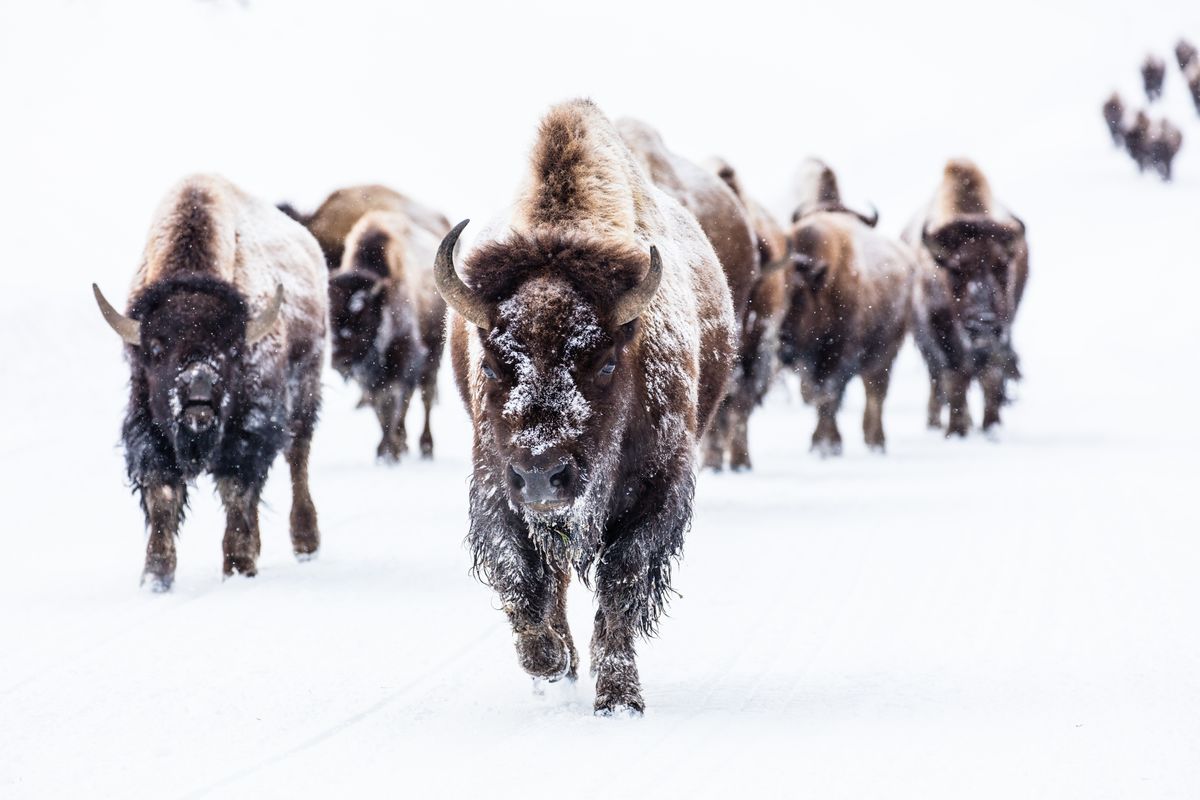Bison have been observed doing this.
There's no evidence that bison know facing a storm will get them through it quicker. Rather, their fur and metabolism give them the ability to withstand the conditions.
While other ungulates, like cattle, tend to go the opposite direction of blizzards, it's unknown whether other animals do what bison do — or whether they would if facing similar circumstances (not all animals deal with blizzards).
Clocking in at up to 2,000 pounds and 6 feet tall, bison are the largest mammal in North America. Because bison are residents of all 50 U.S. states, some of them are exposed to temperature extremes during the coldest months. To combat this cold-weather subjection, some social media users claim, bison walk through snowstorms because "they instinctively know that walking into the storm will get them out of the weather quicker."
A version of the claim appeared in a post shared to X (formerly Twitter) on Feb. 15, 2024, (archived here) that had more than 108,000 views at the time of this publication:
(@earthcurated/X)
The above theory is supported by a 2020 explainer published online by the National Bison Association (archived here), a self-described "non-profit association of producers, processors, marketers and bison enthusiasts."
Bison have indeed been observed exhibiting this behavior, but there is no evidence that they know facing a storm will get them through it more quickly. Rather, their fur and anatomy give them the ability to withstand extreme conditions. While other ungulates, like cattle, tend to go the opposite direction of blizzards, it's unknown whether other animals do what bison do — or whether they would if facing similar circumstances (not all animals deal with blizzards).
Therefore, we have rated this claim as a "Mixture."
Jim Matheson, executive director of the National Bison Association, told Snopes in an email that there is anecdotal evidence that "bison will face a snow storm as not to get stuck in snow drifts and succumb to the elements as cattle tend to do in blizzards." For example, tens of thousands of cattle died in South Dakota during a "freak blizzard" in 2013, yet not one bison was reported dead.
Snopes also spoke with Jeff Martin, a bison specialist and professor at South Dakota State University, who published research on the topic in 2022. In an email, Martin said that while bison have been known to face a storm, it is unknown whether this behavior is intentional. Martin wrote:
The phrase "the only animals" seems difficult to ascertain because not all animals have been observed in blizzards. We do know that bison have something like this behavior and cattle do not, but we do not know about all the other species.
It is also difficult to assign intent behind behavior. It is observed that bison face into the storm more so than walk into the storm, as observed by [19th century rancher] Charles Goodnight. We do know that cattle tend to "drift" with the direction that the storm blows, often trapping them in corners of fenced pastures.
Bison are extremely cold-tolerant and can maintain their metabolic rate down to minus 80 degrees Fahrenheit, according to the Canadian Bison Association. This, Martin said, reduces their intake requirements but also reduces their required outputs for maintaining body weight, allowing proportionally more energy to be allocated for thermoregulation.
Whereas other ungulates, like cattle and horses, usually expose their backs to the direction wind is coming from, bison will face the storm to prevent "snow, ice, and cold air from blowing under their coats and thus becoming chilled," according to the Canadian Bison Association.
"When bison face into the storm (whether lying down, standing, or walking), they use the forward-facing, more dense part of their hair and hide for insulation against the cold. Those long guard hairs help to wick away any moisture from their skin and help to limit the effect of wind chill," Martin explained to Snopes.
Bisons' coats play a special role in their survival, with multiple layers to the overall structure of their haircoats. Martin explained:
The long guard hairs help wick away water from the skin and reduce the wind chill effect on their bodies. The dense woolly undercoat acts as the insulation to retain warmth. These woolly undercoat hairs are hollow which increases thermal efficiency. Additionally, there are 4.5 times as many hairs per square inch for bison (~19,300) compared to cattle (~4500).
Paul Stoy, a professor of agriculture at the University of Wisconsin-Madison, agreed, adding that calling a bison facing into a storm an "instinctive" behavior is a "bit of a stretch" for practicality's sake. Even if a bison were walking into a storm, the amount of time it could shave off wouldn't be worth the amount of effort it would take to move during a blizzard. Stoy told Snopes:
To fit the technical description of a blizzard, noting that all snowstorms aren't blizzards, winds have to be traveling at least 35 mph and can last a few hours. Assuming that [bison are] not walking through snow at a rate of more than 3 mph – and probably far more slowly – they might be able to save themselves a few minutes of blizzard conditions, but I'd hesitate to suggest that this would be at all energetically favorable versus just taking it easy during the snowstorm because walking upwind through snow would incur a large energetic expense.
"A more plausible explanation is that they may face a storm more often than other animals because their heads and shoulders tend to be very well covered by fur," Stoy added.

